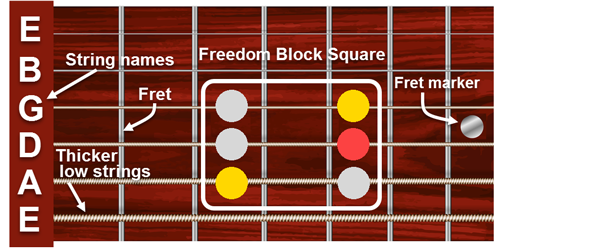Minor Pentatonic Freedom Blocks
We'll start with the most popular improvisation scale, the minor pentatonic.
The five-note minor pentatonic scale is a scaled down version of the seven-note natural minor scale. Below is an F minor pentatonic scale laid out on the low E string. The 2nd and 6th notes of the minor scale are removed, and two of the remaining notes are moved down one fret . This will not be on the final exam. There is no final exam.
(Notation for F major scale: E1-3-5-6-8-10-12-13)
(Notation for F minor pentatonic scale: E1-4-6-8-11-13)

What's left are three narrow (2-fret) intervals and two wide (3-fret) intervals.

The narrow intervals form a square and the wide intervals form a rectangle.

Lead guitar players love the minor pentatonic scale, because they don't have to worry about playing unpleasant or dissonant notes. If their band is playing an A minor chord or key, they can play any of the five notes in the A minor pentatonic scale, anywhere on their guitar and they'll sound good.
Red Notes are Special
The red root notes are the root note of the scale or key of a song. Scales are like roller coasters, you go up and down, fast and slow, but there's always that point of relief when you reach a flat spot, even if two seconds later you're hanging upside down in a barrel roll. The point of relief or resolution in music is when you land on the root of the scale.
I'll refer to these intervals as rows 1, 2, and 3.

Here are a few more definitions before we get started.
